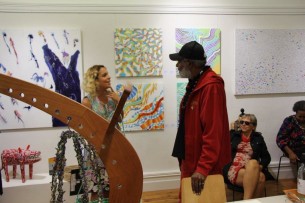Elisa Jane
is a Salt Water Murri, an Indigenous Contemporary Artist from North Stradbroke Island, Queensland. She is a descendant of the Ngugi people, one of the 3 clan groups of the Quandamooka people of Moreton Bay, Queensland, Australia, the people of the sand and seas, Yoolooburrabee.
Leecee was living in London for 18months until recently resettling in Brisbane. During her time in London, she exhibited her first solo collection ‘Mumberleya Tumbe’ and was selected for a group exhibition at the London 02 arena.
She also exhibited in various spaces throughout East London and was chosen to perform for New York Feminist artist, Emily Roysdon’s live performance in London. Leecee is always involved in interesting and cutting edge projects and was named a Helicopter Camera Queen at the Tate Modern Gallery.
Leecee currently lives in Brisbane and apart from creating her own artworks, she is involved with various Indigenous Community Projects including the Wujal Wujal Indigenous Women’s art group.
“I create art to express myself and share my culture with the rest of the world. I think its important to share my families dreamtime stories, life and other cultural aspects with others so they can gain knowledge of the past and celebrate our ways of life. Art allows the viewer to see new concepts on the world we live in. It is important for everyone to have an understanding of the many different cultures and diversity within cultures.
I am a descendant of the Ngugi people from Quandamooka salt water country (Moreton and Stradbroke Islands) off the south east coast of Queensland, Australia. Many people have never heard of this place. I am sharing our beautiful island with them. I like to demonstrate in my art my family’s connections with the land, mother earth and sea, the animals, methods of survival and respecting the environmental conditions. There are many dreamtime stories that need to be shared and I like to capture some of these stories in my art.
In Aboriginal art alone, there are many different art forms depending on which part of the land you come from. Each part of Australia has many urban, rural and remote communities and the art reflects on which area the artist is from. Each part of the land also depicts different dreamtime stories. There is Urban art, Central Australian Art, Traditional Art, Contemporary Art etc. The cultures are displayed in these different art forms but we are all connected as one.”








